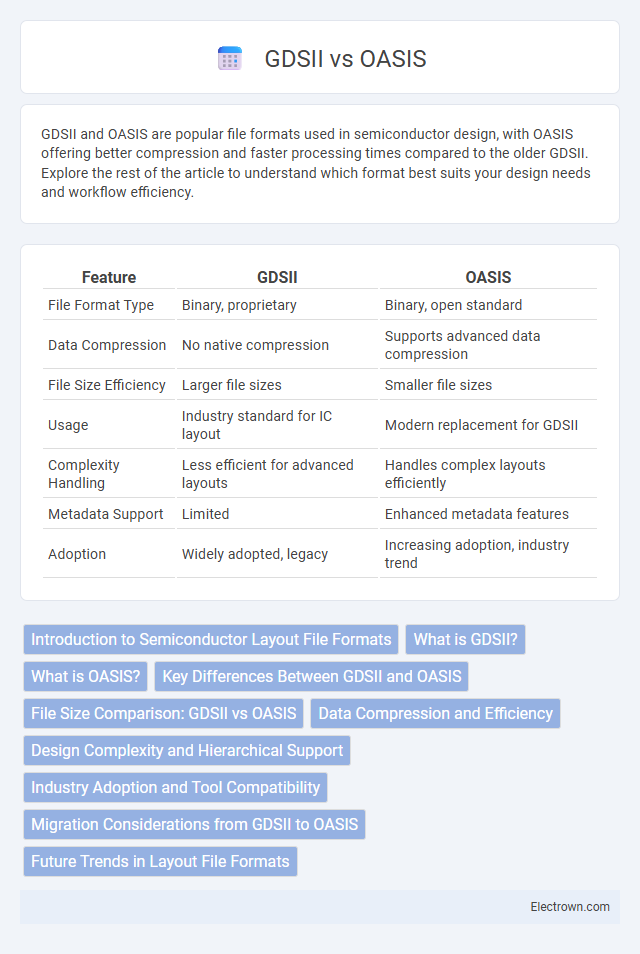GDSII and OASIS are popular file formats used in semiconductor design, with OASIS offering better compression and faster processing times compared to the older GDSII. Explore the rest of the article to understand which format best suits your design needs and workflow efficiency.
Table of Comparison
| Feature | GDSII | OASIS |
|---|---|---|
| File Format Type | Binary, proprietary | Binary, open standard |
| Data Compression | No native compression | Supports advanced data compression |
| File Size Efficiency | Larger file sizes | Smaller file sizes |
| Usage | Industry standard for IC layout | Modern replacement for GDSII |
| Complexity Handling | Less efficient for advanced layouts | Handles complex layouts efficiently |
| Metadata Support | Limited | Enhanced metadata features |
| Adoption | Widely adopted, legacy | Increasing adoption, industry trend |
Introduction to Semiconductor Layout File Formats
GDSII and OASIS are critical semiconductor layout file formats used to store and transfer integrated circuit design data. GDSII, a binary format widely adopted since the 1980s, supports complex polygonal shapes and hierarchical design structures, while OASIS offers higher compression rates and improved data handling efficiency, reducing file sizes significantly. Choosing Your layout format impacts design performance, data exchange, and manufacturability accuracy in semiconductor fabrication processes.
What is GDSII?
GDSII, also known as Graphic Data System II, is a binary file format widely used for representing integrated circuit layouts in semiconductor manufacturing. It stores geometric shapes, text labels, and connectivity data essential for photomask creation and chip fabrication. Despite its widespread adoption, GDSII files can become large and complex, leading to slower processing times compared to newer formats like OASIS.
What is OASIS?
OASIS (Open Artwork System Interchange Standard) is a modern file format designed for integrated circuit layout data, offering improved compression and faster processing compared to the legacy GDSII format. It supports hierarchical data structures and complex polygon geometries, enabling efficient storage and transmission of large-scale semiconductor designs. OASIS reduces file size significantly while maintaining accuracy, making it a preferred choice for advanced semiconductor manufacturing workflows.
Key Differences Between GDSII and OASIS
GDSII, an older file format, stores integrated circuit layout data in a binary format, leading to larger file sizes and slower processing compared to OASIS. OASIS uses advanced data compression techniques and hierarchical data structures, significantly reducing file size and improving data handling efficiency. The enhanced efficiency of OASIS supports faster design iterations and better management of complex semiconductor layouts in modern electronic design automation (EDA) workflows.
File Size Comparison: GDSII vs OASIS
OASIS files typically exhibit significantly smaller file sizes compared to GDSII, often reducing storage requirements by 10 to 20 times due to advanced data compression and encoding techniques. GDSII format uses a straightforward binary encoding that leads to larger, less efficient files, especially for complex integrated circuit layouts. The compact nature of OASIS improves data handling, transmission speeds, and storage efficiency in semiconductor design workflows.
Data Compression and Efficiency
OASIS offers significantly higher data compression rates compared to GDSII, reducing file sizes by up to 90%, which enhances storage efficiency and accelerates data transfer. The binary-based structure of OASIS optimizes data representation, allowing for faster processing and reduced input/output operations in semiconductor design workflows. GDSII, being an older ASCII-based format, often results in larger files and slower handling, impacting overall design efficiency.
Design Complexity and Hierarchical Support
GDSII and OASIS are key file formats used in semiconductor design, with OASIS offering superior handling of design complexity due to its advanced data compression and support for large-scale layouts. OASIS provides enhanced hierarchical support, allowing more efficient representation of repetitive structures and reducing file size compared to GDSII's flatter hierarchy. Your semiconductor design workflow benefits from OASIS's ability to manage intricate layouts more efficiently, improving both storage and processing speeds.
Industry Adoption and Tool Compatibility
GDSII remains widely adopted across semiconductor design due to its longstanding presence and broad tool compatibility, supporting legacy workflows and enabling easy data exchange. OASIS offers enhanced efficiency with smaller file sizes and faster processing, gaining traction among advanced foundries and EDA tools optimized for next-generation designs. Your choice between GDSII and OASIS depends on balancing industry standardization with modern tool support and project requirements.
Migration Considerations from GDSII to OASIS
Migration from GDSII to OASIS requires careful evaluation of file size reduction benefits, as OASIS can shrink data by up to 90% compared to GDSII, improving storage and transmission efficiency. Your workflow must account for compatibility with existing design tools and verification suites to ensure seamless integration without data loss or errors. Assessing the learning curve and conversion tool accuracy is critical for minimizing downtime and maintaining design integrity during the migration process.
Future Trends in Layout File Formats
Future trends in layout file formats emphasize higher compression rates and faster data processing, with OASIS widely recognized for its superior efficiency compared to GDSII. As semiconductor designs grow increasingly complex, OASIS's ability to handle larger data volumes with reduced file size positions it as the preferred choice for advanced chip manufacturing. Your workflow will benefit from adopting OASIS, which supports improved scalability and integration with modern EDA tools, aligning with the industry's push towards more compact and efficient layout representations.
GDSII vs OASIS Infographic

 electrown.com
electrown.com